 GEOLOGIC TIME
GEOLOGIC TIME

Chapter 6: Geologic Time, Geologic Processes Past and Present - Uniformitarianism
And it seems like the time when after doubt
Oh, never this whelming east wind swells
But it seems like the sea's return
To the ancient lands where it left the shells
Before the age of the fern;
And it seems like the time when after doubt
Our love came back amain.
Oh, come forth into the storm and rout
And be my love in the rain."A Line-Storm Song," Robert Frost (1913)
 GEOLOGIC TIME
GEOLOGIC TIME

| A lot of things that happen during geologic processes, such as the cooling and crystallizing of a magma, the erosion of landmasses, the transport of sediment by rivers, the filling up of ocean basins, all these processes can be observed in action in nature or in laboratory analogues (melting and crystallizing of rock in the lab, crystallization of salt from solution, weathering of building stones, floods of rivers, erosion of river banks, the filling in of embayments on the Mississippi delta within some decades). We are reasonably adept at manipulating the physical world in terms of spatial relationships and physical parameters (temperature, pressure), but one dimension of the physical world has so far escaped our manipulative powers TIME . Nonetheless, the writers of science fiction novels routinely use time travel to get themselves and their heroes/heroines out of trouble. | The time traveler's machine from the 1950's George Pal adaptation of the H.G. Wells classic "The Time Machine". |
Time is comprehensible to us as long as we can track it in terms of seconds, minutes, hours, days, and years, but once we go beyond the realm of our own time experience, our perception tends to get fairly vague. For example if I were to ask when Napoleon [1769-1821] was born, I would be lucky to get an answer like "sometime in the middle of the 18th century". We basically have trouble to visualize time intervals that are significantly larger than our own lifespan.
Time is a very important variable in geology, because the exact timing of spatially separated events allows us to reconstruct the surface and surface conditions of the ancient earth. It also allows us to put events into chronological order and by those means to deduct the driving forces behind the continual changes of the Earth.
Geologic time spans are considerably more difficult to comprehend than historical time spans because they are so incredibly long. For a long time there was considerable debate on the length of geologic time spans and the age of the earth. For example, from literal study of the bible an Irish bishop (Bishop Ussher, 17th century) counted the days from the beginning of the biblical record, and concluded that the earth was created 4004 years B.C., on October 26th, at 9:00 am. This of course did not please early geologists, because from the study of thick sedimentary sequences alone (comparing them with modern sediments) it appeared that the earth must be at least hundreds of millions of years old, may be even billions of years (the problem was to prove it).
In 1715, Edmund Halley (yes, the one the comet is named after) suggested that the salt content of the oceans might be a way to get a minimum estimate of the age of the Earth. Weathering produces dissolved salts that get carried into the oceans by rivers. If we measure the rate at which various salts are added to the oceans by weathering, we could calculate the time it took to reach modern day salinity. This suggestion was picked up by John Joly who did the actual calculation in 1889. He came up with a figure of 90 million years for the age of the oceans. The problem with this estimate is, that salts are also taken out of circulation by reactions with seafloor volcanic rocks, and by forming evaporites that get buried in sediments and are thus out of circulation. Thus, salts get added to the system (weathering, volcanism) as well as being removed from it (interaction with ocean crust, burial as evaporites), and the result is an ocean that has been more or less stable in its salinity for hundreds of millions of years. Nonetheless, 90 million years is a vast improvement over 6000.
Then in the 19th century came along Lord Kelvin who calculated that if the earth was originally in a molten state, it would have taken about 20-40 million years to cool to its present temperature. He did of course not know that new heat is constantly produced by radioactive decay. Thus, he underestimated the age of the earth significantly. Geologists still suspected that 100 million years were too short a time, but it was not until the introduction of radiometric age determinations and the development of sensitive mass spectrometers that we did learn that the age of the earth was about 4.5 billion years.
UNIFORMITARIANISM VS CATASTROPHISM
Initial thinking on earth history was inspired by the bible. The recognition that major rock series are characterized by a distinct set of fossils lead to the belief that the fossils of each rock series were result of a creation and then were subsequently destroyed by some catastrophic event (e.g. the biblical flood). The main proponent of this theory was the French naturalist Georges Cuvier. In the 18th century there was even a case when some unfortunate geologist (Johann Jacob Scheuchzer, 1672-1733) found skeletons of giant salamanders and identified them as the victims of the biblical flood. The problem was that upon close inspection, these flood victims had long tails and sharp claws. Thus, it earned the proponent quite a bit of ridicule. Generally speaking, this way of looking at the geologic record, namely to assume that a series of immense, brief, and worldwide upheavals changed the earth greatly and produced mountains, valleys, and various other large scale features, came to be known as catastrophism.
The theory of catastrophism was challenged by James Hutton in the late 18th century, who in his theory of uniformitarianism proposed that uniform gradual processes (such as for example the slow erosion of the coast by the impact of waves) shaped the geologic record of the earth over an immensely long period of time. He assumed that the acting processes were the same than those that we see in action at present (rivers, volcanoes, waves, tides etc.). Darwin later on based his theory of the origin a species on Hutton's theory.
The sedimentary structures that we saw earlier in this lecture serve as a good illustration how uniformitarianism works. Cross-bedding for example can be observed to form in modern river channels and also in experimental setups called flumes. We learn from these observations what kind of current velocities are needed to produce cross-bedding in a given grain size, and we realize that cross-bedding can be used as an indicator of current flow direction. We can apply what we learn from modern cross-beds to interpret the rock record in terms of flow velocities and flow direction. Likewise, finding ancient equivalents of modern mudcracks suggests to us that we look at sediments that dried out beneath the air, and were thus deposited on land.
In more modern times, some amendments have been made to the theory of uniformitarianism. One of these would be that it was recognized that catastrophic events are as much part of geologic history than the uniform action of the everyday processes. For example, sediment supply to the oceans is not a constant flux of matter. There is a considerable episodic component to sedimentation, e.g. storms are major agents of sediment redistribution in shelf seas, floods and exceptionally strong rains are responsible for most of the erosion and sediment redistribution on the continents. Undoubtedly, the physical and chemical principles (e.g. gravity, thermodynamics) that govern geologic processes of the present have also applied in the past. Yet as is visible in the present, frequent small deviations from equilibrium and unstable behavior (minor catastrophes, such as earthquakes, floods, storms) must have been an integral part of these processes. Similarly, the evolution of life was not a single succession of tiny evolutionary steps as originally envisioned by Darwin. We are now able to see that there were episodes of accelerated (punctuated) evolution, usually as a response to a change in environmental conditions, such as climate (ice ages, warming of the earth), the advent or immigration of new predators and the utilization of new food sources. Extremely rare (and catastrophic) events, such as the impact of large meteors, may have had a profound influence on our planet. Yet meteors fall onto the earth on a daily basis, just as it rains every day. In that sense, meteorite impacts are quite normal and part of the spectrum of everyday processes. Only very rarely does a "doomsday" meteorite that is 10 or more km in diameter hit the Earth and cause severe disruptions. To sum it up: The natural laws do not change with time and they have and will determine interior and external processes of the earth. Even the extremely rare event (e.g. meteor impacts) is part of the many geologic processes governed by these laws. Even though something, like for example the December 2004 tsunami, appears to us as a unique catastrophe, over the long run it is a normal and recurring event. It does not follow, however, that the rate of geologic processes is the same today as it was in the past. Some processes, such as mantle convection do probably stay stable over long time periods, but others, such as glaciation were at times very intense in the past (ice ages), but are presently less significant for continental erosion. So, a brief definition of Uniformitarianism would be: the natural laws that govern geologic processes have not changed over geologic time, but the rate at which certain geologic processes operate can vary. Uniformitarianism also has been paraphrased as "The Present is the Key to the Past".
DETERMINING RELATIVE AGE RELATIONSHIPS IN GEOLOGY
As said earlier, geologists for a long time had an appreciation of geologic time, but they did not know the absolute length of it. Initially all time considerations done by geologists were of a relative nature (basically, we were able to tell whether one rock was older or younger than another one). Even though they do not give us an absolute age, the methods for relative age determination are very important because they allow us to establish the chronology of events in earth history. There are basically four approaches with which geologists can determine relative age relationships:
Events can be ordered using these various methods even when no absolute ages can be measured. Where there is a break in sedimentation, a period of erosion or an episode of deformation, the rock layers record the break as a surface called an unconformity. Unconformities range from minor erosional breaks to strong angular discordances in bedding. An unconformity indicates a period where no rock record is accumulated. They are time-breaks of indeterminate length. There a basically three types of unconformities:
The diagrams below illustrate these types of unconformities:
 |
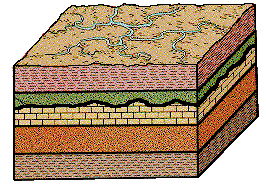 |
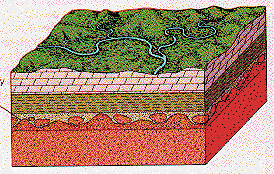 |
| Angular Unconformity Disconformity Nonconformity | ||
More info on relative geologic age here.
The Standard Geologic Column
Without the benefit of modern day radiometric age determination, geologists were nontheless able to use the methods of relative age determination outlined above to work out the relative chronology of the rocks exposed on the Earth's surface. This sequence of rocks is also called the standard geologic column.
 |
The major subdivisions (Eons)
of the geologic column are the
Precambrian and the
Phanerozoic.
The Precambrian contains the lions share (almost 4
billion years) of earth's history, but we know comparatively little about it because the
rocks have often been metamorphosed, and because they do not contain readily recognizable
fossils. The Precambrian and Phanerozoic can be further subdivided into Eras (Hadean
etc.). The fossiliferous rocks of the Phanerozoic also allow further subdivision
into Periods and Epochs (see more detailed
time scale). The numbers in our more
detailed time scale are in millions of years and represent radiometric ages, derived
from lavaflows, ashfall deposits, etc. More info here. |
The oldest Era in the geologic column is the PRECAMBRIAN, and until the advent of radiometric age determinations it wasn't really appreciated that this unit by itself makes up the lions share (almost 4 billion years) of earth's history. It has only in recent decades received a lot of attention because the bulk of earth history is locked up in it. These rocks are in many places metamorphosed and strongly deformed (long history), but there are also plenty of places where they are unmetamorphosed and only mildly deformed. Because these rocks do not contain conspicuous fossils such a clam and snail shells, trilobites, sea urchins etc. (microfossils and fossil algae are common) they were for a long time thought to be devoid of fossils. Therefore most of the early geologists did not bother very much with them.
The Precambrian Era is followed by the Paleozoic Era (ancient life), which can be subdivided into six periods, the CAMBRIAN (Cambria, the Roman name for Wales), which contains the oldest hard shelled fossils (that's why the underlying, seemingly fossil free, rocks were called Precambrian), the ORDOVICIAN (named after a celtic Welsh tribe, the Ordovices), with fossils that differ from the Cambrian ones, the SILURIAN (after another celtic Welsh tribe, the Silures), the Devonian (outcropping in Devonshire, SW England), the CARBONIFEROUS (so called because it contains abundant coal seams; in the US subdivided into Mississippian and Pennsylvanian), and the PERMIAN (Perm in Russia)..
The Mesozoic Era (middle life) can be subdivided into three periods, the TRIASSIC, lots of red beds, deserts dominate land surfaces (named in Germany where we have a threefold subdivision), the JURASSIC (limestone/shale sequence of the Jura Mts., Switzerland), and the CRETACEOUS (predominantly chalk in Europe; Latin "creta"= chalk).
The youngest era is the Cenozoic Era (recent life), which is characterized by fossils that very closely resemble modern animals. It is subdivided into the TERTIARY and the QUATERNARY. The latter consisting of the youngest sediments (unconsolidated) with fossil species that still have living counterparts. The Quaternary period includes the advent of man and the four ice ages of recent earth history.
ABSOLUTE AGE DETERMINATION
We can determine the absolute age of rock units by two principal methods:
(1) Methods that relying on events in the geological record that show very strong
annual cyclicity:
Growth Rings of Trees
Coral Growth Cycles
Varves (annual clay layers in glacial lakes)
With these methods we can produce continuous chronologies that may go back for almost
10,000 years, thus they are only useful for determining the age of very recent features.
(2) Methods that rely on the decay of naturally occurring radiogenic isotopes (such
as):
| Parent Isotope | Daughter Isotope | Half-Life (Years) | Radiometric age determination is not without difficulties, but is by far the most widespread method for determination of absolute ages between 100 and 4500 My. Uranium, Thorium and Potassium provide the most common radiogenic isotopes in the Earth's crust. Radiocarbon is important for determining the age of organic remains from the relatively recent past. Bomb tritium (from atmospheric nuclear tests) has been used extensively to trace groundwater movements over periods of tens of years. |
| Carbon-14 | Nitrogen-14 | 5,730 | |
| Uranium-235 | Lead-207 | 710,000,000 | |
| Potassium-40 | Argon-40 | 1,300,000,000 | |
| Uranium-238 | Lead-206 | 4,500,000,000 | |
| Thorium-232 | Lead-208 | 15,000,000,000 | |
| Rubidium-87 | Strontium-87 | 47,000,000,000 |
The Workings of a Radioactive Clock Radioactive atoms are unstable and as they decay they fall apart into new atoms under emission of radiation. Each radioactive element or isotope decays at a specific rate. The decay law follows an exponential function (see below), in which the so called half-life is a constant in the exponent. The half-life is the time it takes for 50% of a radioactive element to decay. This time is the same regardless of the amount of the element present, and this property of radioactive elements leads to the exponential decay law. Thus after one half-life has passed 50% of our original material has decayed, and new atoms, the daughter product (ion or atom), have accumulated. If we know the half-life of a radioactive element we just have to measure the abundance of the original element (parent) and the daughter element, and we can calculate how much time has elapsed since the decay started. For a radioactive element to be of use for geological age determinations it has to be relatively abundant, and it needs to have a reasonably long half-life (many million years). Isotopes of potassium, uranium, thorium, and rubidium are most commonly used for age determinations in geology (see table above).
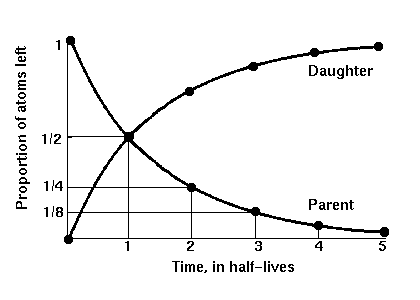 |
All radiometric methods of age determination utilize the fact that certain elements
and isotopes do undergo radioactive decay spontaneously, following an
exponential
decay law. The decay law can be written as:  where No is the initial number of atoms, T1/2 is the half-life of the isotope, and t is the time that has elapsed since decay started. |
Of course, in order to be of use, the original element (parent) and its daughter products have to stay together in the rock, in order to yield useful ages during analysis. Therefore melting or heating of a rock may reset the radiometric clocks, because either daughter products or parent material may separate (leading to an erroneous age).
One of the most widely used methods in geology is the potassium-argon method. The potassium 40 isotope (19 protons, 21 neutrons) decays to argon 40 (18 protons, 22 neutrons) by electron capture and transformation of one proton to a neutron (under emission of radiation). The half-life for this decay is 1.5 billion years. Thus, if we started with 1 gram of 40K, after 1.5 billion years there would be only 0.5 gram left, but we would have created 0.5 grams of radiogenic argon. Argon is a gas and tends to escape, thus we need some mechanism for trapping the Ar close to where it originated. In rocks this is achieved by trapping of argon in minerals. Many rock forming minerals contain large amounts of potassium (K-spar, biotite, muscovite), and fortunately, the argon atoms are too large to move out of the crystal structure. They are therefore trapped right at the decay site of the parent potassium. However, when the temperature of these minerals rises above about 200 degrees Celsius, the thermal expansion and stronger thermal vibration allow the argon to leak from the crystal (leakage rate will increase with temperature). Thus, when a magma crystallizes, the newly forming minerals will freeze in the time when the magma crystallized and solidified. In a metamorphosed sediment the K/Ar ratio will indicate the time of metamorphism. However, if that magma or that metamorphic rock should get heated up again after that, the accumulated argon can escape, and the K/Ar clock is reset to 0. Thus a K/Ar determination tells us only the time of the last heating/cooling episode. Not all radiometric clocks are subject to resetting by heating (U/Pb, Rb/Sr) but they may be affected by differentiation and selective removal of some components during heating. Because heating is important for setting of radiometric clocks, igneous and metamorphic rocks are best suited for radiometric age determination. The most useful isotope pairs for determining the age of rocks are those involving elements found in common silicate minerals. The Potassium-Argon and Rubidium-Strontium pairs (see table above) are most useful in this respect.
In contrast to methods of relative age determination, radiometric methods yield a definite age (in years). We are used to measure time by counting regularly recurring events, such as lunar cycles, the recurring of seasons, days as imposed by the earth's rotation. Thus these naturally recurring events are our natural clocks that have been used throughout human history. The (in statistical terms) regular decay of radioactive elements is just another natural clock, its just a bit more complicated to read. More on radioactive age determination here.
IN SUMMARY WE MAY SAY THAT RADIOMETRIC AGE DETERMINATIONS HAVE HELPED US TO SCALE OUR GEOLOGIC COLUMN, HELPED US TO DETERMINE THE ABSOLUTE AGE OF THE EARTH, AND HELPED US REALIZE THAT MOST OF EARTH HISTORY IS CONTAINED IN THE LOWLY PRECAMBRIAN. For a long time little effort was made to differentiate the Precambrian in the same detail as younger rocks, mainly because of the lack of fossils useable for biostratigraphy (there are fossils, but no hard parts, morphology related to substrate). However, in recent years major efforts have been undertaken to change this situation, particularly using radiometric age determinations on lavas, ashes and diagenetic minerals (feldspars growing in pore spaces etc.). Radiometric age determination does and will play a very important role in the detailed deciphering of this largest portion of Earth's history.
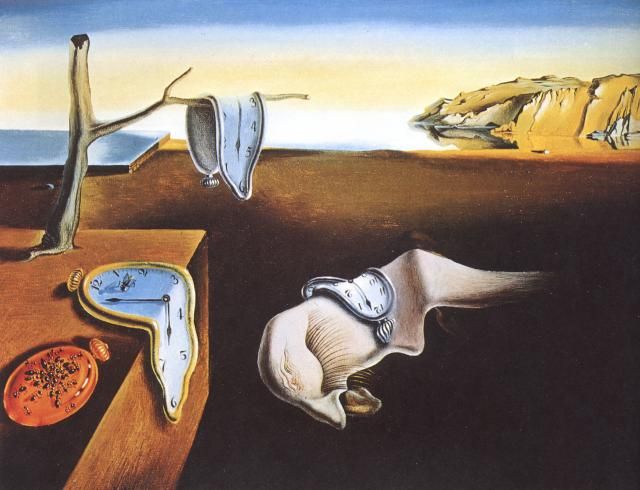 |
Time in the Arts
Time according to Salvador Dali (1904-1989)
one of the pre-eminent Surrealist painters.
|
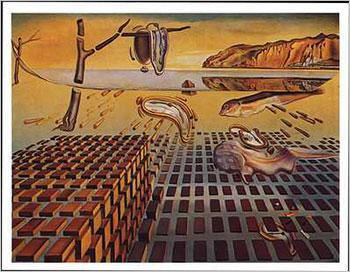 |
Disintegration of the Persistence of Memory (1952 -
54) The disintegration is seen as an acknowledgment of the developments of modern science. It is the time after the "bomb". All of the elements in the painting are separating from each other. The rectangular blocks in the foreground and the rhinoceros horns floating through space metaphorically suggest that the world is formed of atomic particles that are constantly in motion. In spite of the painting's bleak implications, Dalí presents the atomic disintegration in a harmonious pattern, indicating the persistence of an underlying order in nature. Painting located at the Salvador Dali Museum in St. Petersburg, Florida. |
Find out more about geologic time at the USGS web site.
the background tune is "As time goes by", made famous in the movie Casablanca